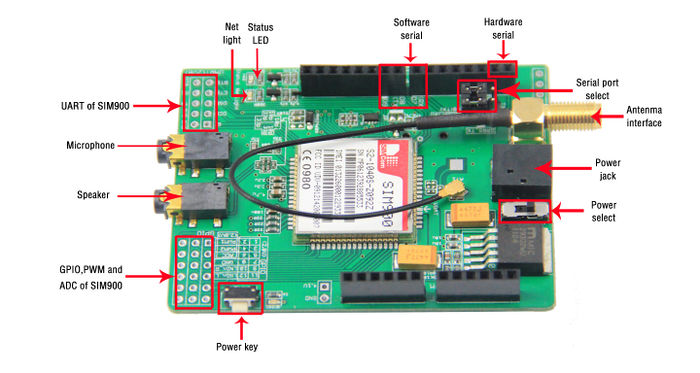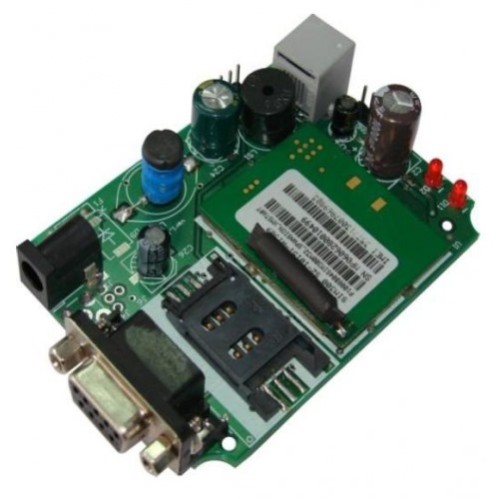The SIM300 is a GSM/GPRS module produced by SIMCom, designed for wireless communication in a variety of applications. It allows devices to connect to cellular networks for voice, SMS, and data communication. Here’s an overview of the SIM300 module:
Key Features:
-
GSM/GPRS Capabilities:
- GSM: Supports voice communication and SMS (Short Message Service).
- GPRS: Provides data connectivity, enabling internet access and data transmission over cellular networks.
-
Frequency Bands:
- GSM Bands: Operates on multiple frequency bands, including 900 MHz and 1800 MHz (or 850 MHz and 1900 MHz in North America), which cover most global GSM networks.
-
Interfaces:
- Serial Communication: Communicates via UART (Universal Asynchronous Receiver-Transmitter) for connecting to microcontrollers or other devices.
- Power Supply: Operates on a typical voltage of 3.4V to 4.4V, usually requiring a stable power source.
- I/O Pins: Includes pins for controlling various functions such as power, reset, and serial communication.
-
SIM Card:
- SIM Slot: Accommodates a standard SIM card, allowing the module to connect to cellular networks.
-
Communication Protocols:
- AT Commands: Uses AT (Attention) commands for controlling the module and performing operations like sending SMS, making calls, and accessing the internet.
- GPRS Data Protocols: Supports standard data protocols including TCP/IP for internet connectivity.
-
Additional Features:
- SMS Storage: Capable of storing incoming and outgoing SMS messages.
- Power Management: Includes power-saving modes to reduce energy consumption.
Applications:
- Remote Monitoring: Ideal for sending data from remote sensors or monitoring systems to a central server or database.
- M2M Communication: Enables machine-to-machine communication, useful in IoT (Internet of Things) applications.
- Voice and SMS Communication: Supports applications requiring voice calls and SMS functionalities.
- GPS Integration: Can be used in conjunction with GPS modules for location-based services.
Example Connection with Arduino:
To connect and use the SIM300 module with an Arduino, follow these steps:
Wiring Instructions:
- SIM300 to Arduino:
- VCC (SIM300) to 5V or 4.2V (Arduino) (check module specifications; ensure a stable power supply as SIM300 can be power-hungry).
- GND (SIM300) to GND (Arduino).
- TX (SIM300) to RX (Arduino) (e.g., D2 if using SoftwareSerial).
- RX (SIM300) to TX (Arduino) (e.g., D3 if using SoftwareSerial).
- Reset, PWRKEY, and other control pins may need to be connected according to the module's datasheet or application requirements.

#include
// Create a software serial port to communicate with SIM300
SoftwareSerial sim300(2, 3); // RX, TX pins for SIM300
void setup() {
// Start the hardware serial communication (used for debugging)
Serial.begin(9600);
// Start the software serial communication for SIM300 module
sim300.begin(9600);
Serial.println("Initializing SIM300 GSM/GPRS modem...");
// Wait for the module to initialize and respond
delay(1000);
// Check if the SIM300 is responding by sending the 'AT' command
sim300.println("AT");
delay(1000);
if (sim300.available()) {
while (sim300.available()) {
char c = sim300.read();
Serial.write(c); // Display response on Serial Monitor
}
}
// Send SMS using SIM300 module
sendSMS("Your phone number here", "Hello from Arduino with SIM300!");
}
void loop() {
// Here, you can add more functionality like receiving SMS, etc.
}
// Function to send SMS
void sendSMS(String phoneNumber, String message) {
Serial.println("Sending SMS...");
// Send the AT command to set the SMS mode to text mode
sim300.println("AT+CMGF=1"); // Set SMS text mode
delay(1000);
// Send the recipient phone number
sim300.print("AT+CMGS="");
sim300.print(phoneNumber);
sim300.println(""");
delay(1000);
// Send the SMS message
sim300.println(message);
delay(1000);
// Send the Ctrl+Z character to send the SMS
sim300.write(26); // ASCII code for Ctrl+Z
delay(1000);
// Wait for the response and print it to Serial Monitor
if (sim300.available()) {
while (sim300.available()) {
char c = sim300.read();
Serial.write(c); // Display response from SIM300
}
}
Serial.println("SMS Sent!");
}

















